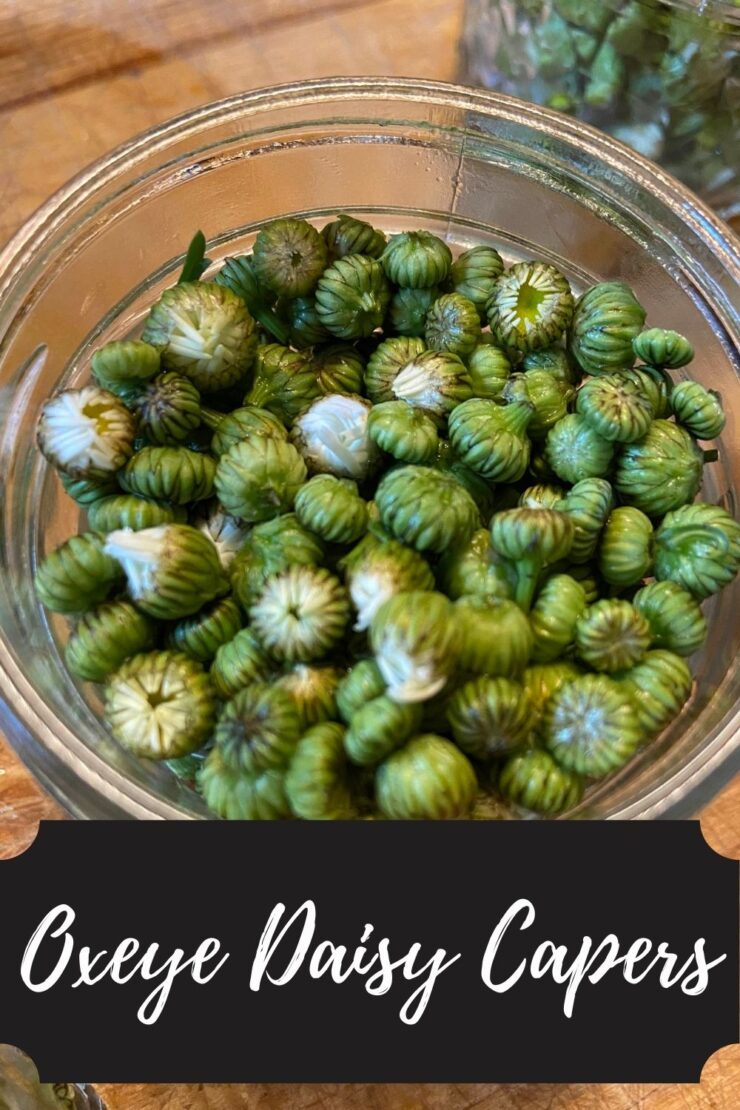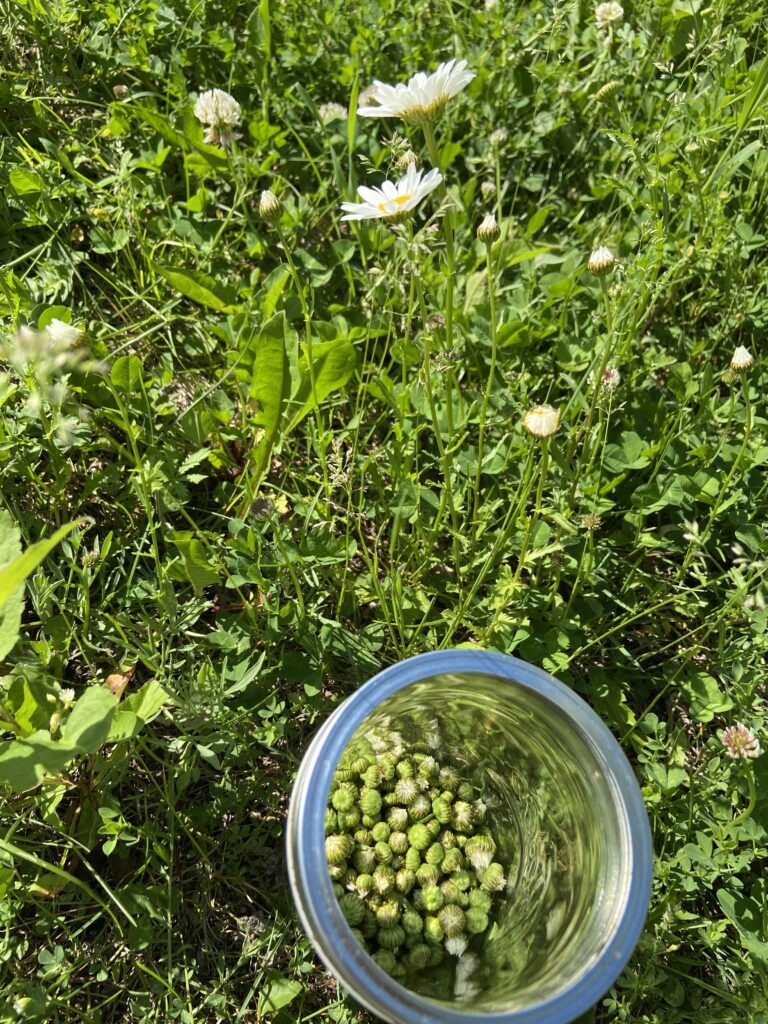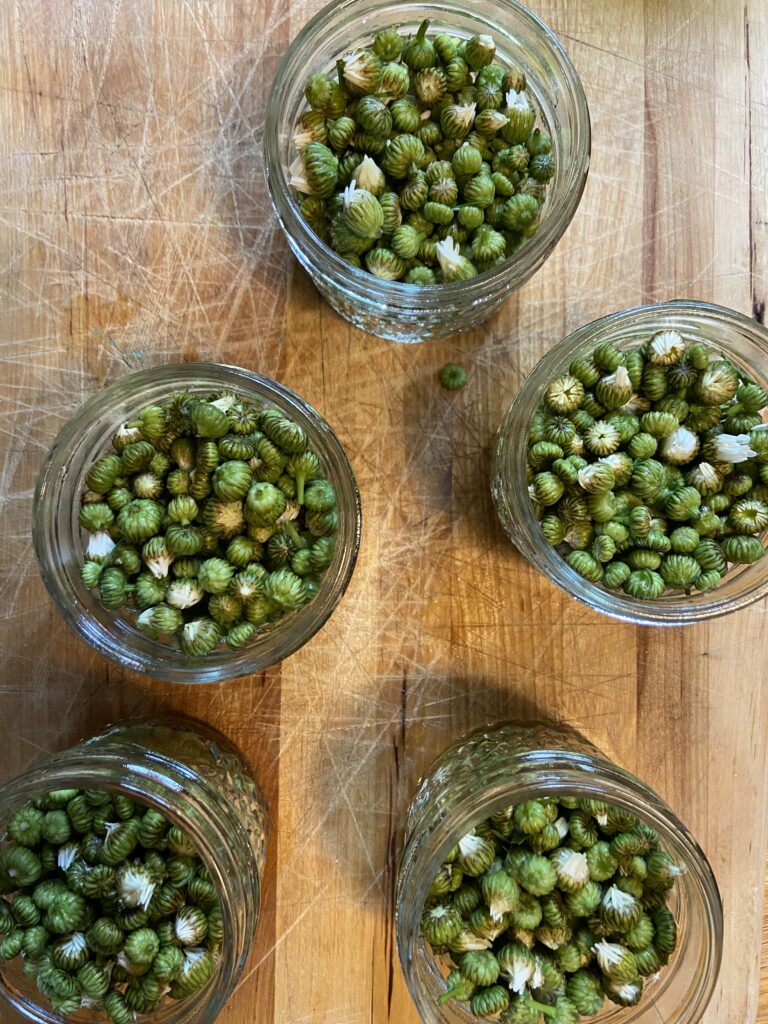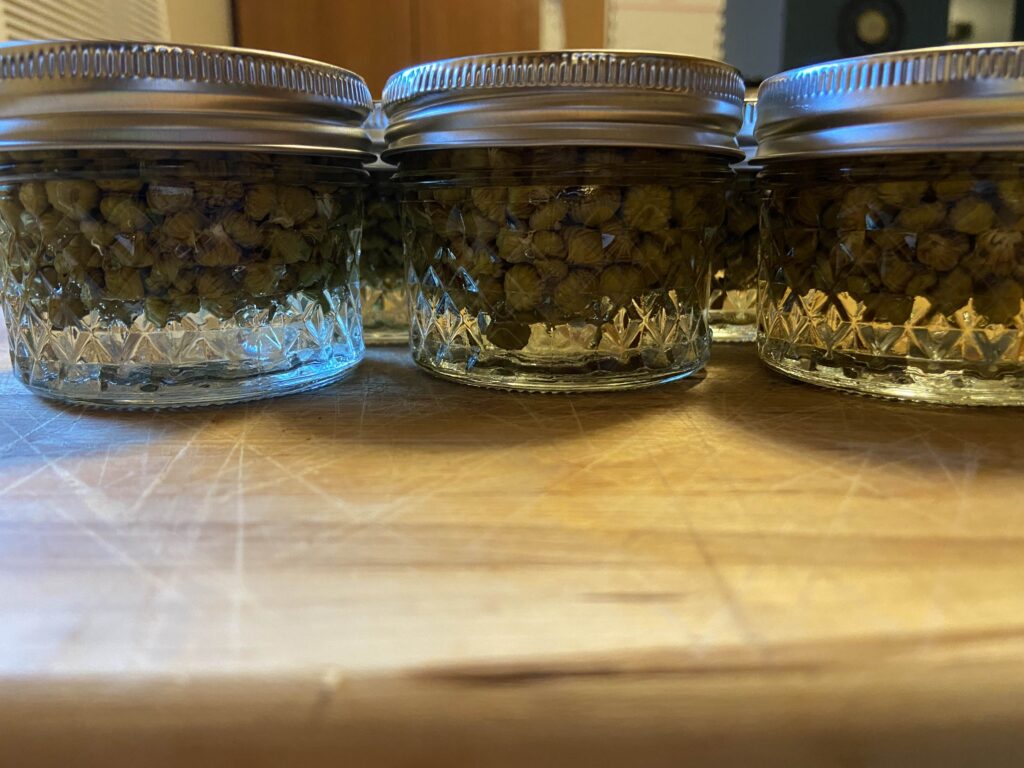Once I started learning about foraging, wild edibles was all I thought about as I walked around the yard, went for walks on the road, went to state parks…you get the idea. I would look with intent, wondering what was edible. If it was edible, I then would wonder if it tasted any good. As my husband would say, “Just because you CAN eat it, doesn’t mean it isn’t just survival food.” (Case in point: Spruce tree tips. Yes, they just taste like a pine tree. And I like gin. Spruce tips, not so much) However, Ox Eyed Daisy Capers are a great homemade caper if you’re willing to let them rest like you should 🙂
If you’ve read my foraging page, you know that my gateway to foraging was acorns, not the average starting point. This lead to dandelions, which I still LOVE finding uses for. Once such use is dandelion bud capers (You can find a recipe at the link), but by the time I found out about them, the dandelions had given way to summer. Enter the Ox Eyed Daisy.
Ox eyed daisies are edible (both leaves and flowers) and are prevalent in our area. While they are native to Wisconsin, my husband (who works in natural resources) shares that they are border line invasive. In my mind, I hear “Honey! You should cook with them!” and so I did.
The Supplies
Capers are an item that is generally found in smaller quantities. I canned my oxeye daisy capers in 4 ounce jars, which is a great size. I usually use Ball or Kerr jars, but I was gifted these Verone jars, and I love the versatility that they provide with both two and one part lids.
You will need a water bath canner or large stock pot with a lid. The jars need to be off the bottom of the pot. A water bath canner will have a rack to use. If you use a stock pot, I would invest in canning racks. You can also put a towel down in a pinch, but it is MESSY in terms of getting water everywhere.
It is also helpful to have the tools in a canning kit like this, but it isn’t necessary. Canning would be crazy challenging without the jar funnel and jar tongs. The lid lifter is also very handy.
New to canning? Check out the Ball’s Book of Canning or The National Center for Home Food Preservation for more detailed information. I will give you the low down, but it will be short and sweet. You will want to read up more, I promise 🙂
The Process
Harvesting
The buds are small and similar in size to dandelion buds. Well, if you can create capers from dandelion buds, you must be able to make daisy capers, right? So I did. I found the harvesting of the capers strangely meditative. It took time; I had to sit on the ground, move around, looking for perfect, unopened buds. I listened to nature. The birds. The wind. It was calming and what my mind needed. For each four ounce jar, you will need approximately a ½ cup of buds. I took a 24 ounce pint and a half jar outside and filled it. This resulted two cups of buds which made five 4 ounce jars of capers when everything was said and done.
Your Ingredients
- 2 cups oxeye daisy buds
- ¾ cup water
- ¾ cup vinegar (5% acidity)
- 1 ½ tablespoons salt
Canning
Once you have finished harvesting, rinse and drain the buds. Meanwhile, prepare your water bath canner. Fill the canner with enough water so that once the jars are in the canner, they will be covered by at least one inch of water. Too much water is better than not enough, but remember that some water will be displaced by the jars. Cover and begin to heat over a medium-high heat.
Prepare jars, rings, and lids by washing with soapy water and keeping warm. (You should use two part lids) Combine salt, water, and vinegar in a large non-reactive saucepan. Heat to a boil and then reduce to a simmer. As the pickling liquid is heating up, fill each 4 ounce jar with buds, leaving ½ inch head space (Generally speaking, I go to the bottom of the rim).
Ladle pickling liquid over buds, leaving ½ inch head space. Remove air bubbles. Wipe the jar rim with a damp paper towel. Place lids and rings on jars, tightening to finger-tip tight.
Place jars on rack in canner, lower into simmering water, cover, and bring to a rolling boil. Process jars for 10 minutes. Remove from heat and allow to cool 5 additional minutes. Remove the jars from the canner and leave to cool completely over 12-24 hours. Do not touch the lids or the rings, but definitely listen for the ping of the jars sealing. It’s the best!
While you can eat anything pickled immediately, I highly recommend waiting a few weeks before breaking into a jar. The flavor will intensify over time.

Harvesting: Such a calming experience. 
Fill the jars just to the rim. 
Allow to rest after canning!
Hints and Tips
- Be mindful of where you harvest. Make sure you have permission if necessary and that the area you are harvesting from does not have chemicals sprayed on it.
- Daisies are plentiful. There shouldn’t be a concern about whether you are harvesting sustainably as there is with edibles such as fiddleheads.
- As with most pickled foods, daisy capers get better with age. You may be tempted to open the jar soon after you finish processing them. Give them a few weeks for the flavor to become enhanced.
- Interested in learning more about foraging? One book that has been imperative to my learning is Midwest Foraging by Lisa M. Rose. I reference it for everything from identification to various recipes. If you’re a Midwesterner like me, do yourself a favor and order the book. You’ll thank me 🙂
Looking for other recipes? Check out the pages below!




